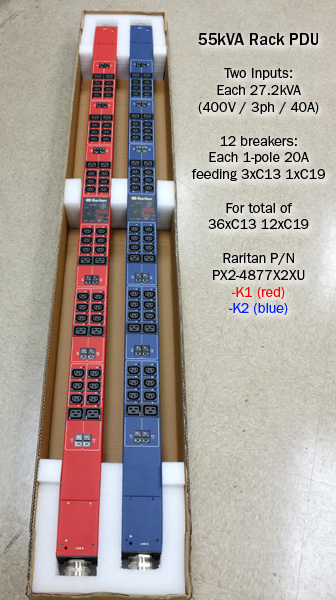The Raritan Blog
Home » Raritan Blog
What a 55kW Rack Power Strip Looks Like
Henry Hsu
April 23, 2013
Last week, Raritan shipped our first production run of—what we believe to be—the highest-density rack power strip in the industry to date.
Like all other Raritan rack power strips sold in North America, these units are UL Listed (bear the true UL Listed Mark). They will be placed in cabinets that will obviously get very hot, so like all Raritan power strips with the part number prefix “PX2”, these units have a maximum ambient temperature of 140°F (60°C) in North American markets.

Although the customer application is confidential, generally speaking, this power strip could easily handle up to twelve blade chassis (with common configurations) in a Tier IV environment:
- The power strip provides 12 individual circuit breakers, each rated at 20A @ 230V. (It’s actually 240V, but in this client’s case they are running 230V).
- That means each breaker can handle a maximum of approximately 4500W (UL489 breakers on our power strips are fully rated, i.e., they can run at their full 20A specification and do not have to be “derated”.)
- This happens to coincide with real-world power draws of many common blade deployments such as HP c7000 or Cisco UCS 5100 series, etc. So each breaker could potentially support a single blade chassis each.**
**This is meant as a generalization. Please be sure to consult your Raritan power architect for more detailed provisioning guidance.
Today, the status quo for cabinet densities tends to be approximately 5 to 10 kW. Raritan has been very fortunate to have partnered with some of the industry’s most forward-thinking data center operators and architects—and have thus designed and deployed a significant number of different power strip configurations at higher densities. For electrical reasons, they cluster in the 14kW, 25kW, 28kW, 33kW, and now 55kW ranges.
It’s a great deal of fun, and I enjoy advising clients on the best way to deploy ever-increasing power densities at a minimal cost.
Here are some more photos, if you’d like to take a closer look:
- Same photo as above, in high-resolution;
- Top of PDU;
- Bottom of PDU;
Please note:
- This application employs a 1” trade size conduit, to provide input power from the RPP—which is why you do not see an input cord.
- We designed this with two 415V, 3-phase, 40A inputs on each power strip—in order to facilitate certain physical connectivity constraints. But the same electrical solution could have been provided with a single 415V, 3-phase, 80A input.
- Nerds may want to know that technically this is a 57.5kVA-rated power strip @ 415V/3phase, and 55.4kVA @ 400V/3phase. Also, while I use kVA and kW interchangeably in colloquial conversations; when consulting a client, I will more typically assume a modern power factor of approximately 97.5%—thus making this a ~56kW (415V) or 54kW (400V) power strip. But that would be an excessively long title for a blog post, so I just split the difference and call it “55kW”, nominally.
I am obligated by law to mention that this power strip happens to be from Raritan’s PX2-4000 Series—which means that in addition to supplying an absurd amount of power, it also provides billing-grade (+/- 1%) kWh energy metering for every inlet, breaker, and individual outlet [C13 and C19]. It is compatible with our wide variety of environmental sensors (temp, humidity, differential air pressure, leak, door open/close); Wi-Fi (802.11a/b/g/n) options; daisy-chaining; USB mass configuration; etc. And it can be queried via either SNMP v1/2c/3 or JSON-RPC.
But enough with the infomercial… fundamentally, I just think it’s awesome to have a single rack PDU that delivers the equivalent amount of power as consumed by five average U.S. homes.
Subscribe
Upcoming Events
- Advancing Data Center Construction West 2024
- May 6 – 8 • Salt Lake City, UT
- Net Zero Data Center
- May 16 – 17 • Dallas, TX
- 7x24 Exchange Spring
- June 9th • JW Marriott Orlando Grande Lakes
Latest Raritan News
- Legrand Certifications and Process Controls Provide Confidence in Information Security for Network-Connected Devices in Data-Related Applications
- Posted on April 1, 2024
- Legrand Releases Version 4.0 of Raritan’s Industry-Leading Secure KVM Switches, Raising Bar for Secure Desktop Access
- Posted on July 31, 2023
- Legrand Revitalizes Data Center Sector with Two Revolutionary Intelligent Rack PDUs
- Posted on May 1, 2023
- Raritan Reveals The MasterConsole® Digital Dual KVM Switch
- Posted on February 18, 2021
- Legrand Data, Power and Control Division Announced as Finalist in Six Categories at DCS Awards 2020
- Posted on November 9, 2020